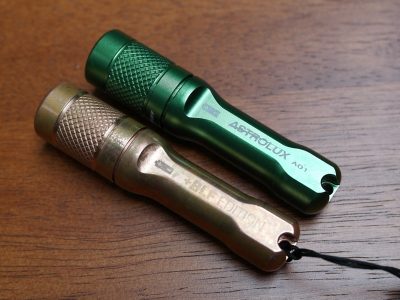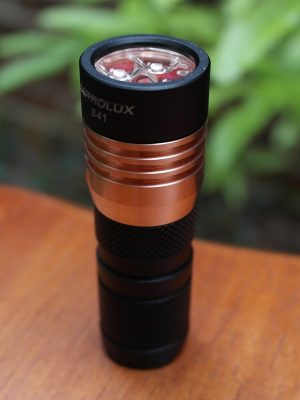Most flashlights are made of aluminum, which is lightweight, strong, and pretty good at conducting heat. For LED flashlights it is important for heat to be carried away from the LED so that it doesn’t overheat and possibly burn. Copper is fantastic at conducting heat, twice as effective as aluminum. However, it also weighs about 3 times as much as aluminum, and is only about one third as strong. It is also typically more expensive.
LED’s are much more efficient than incandescent light bulbs, but still most of the energy they use goes towards heat instead of light. And as you drive the LED harder, it becomes less and less efficient, producing more and more heat. One of my first uses of copper was to wrap copper strips around a P60 drop-in in the head of flashlight, filling up an air gap (air transmits almost no heat) and allowing heat from the drop-in to sink into the head and body of the flashlight. I used aluminum strips at first, cutting 1″x3″ strips from aluminum cans, but eventually I bought some sheets of copper and cut that into strips. Here’s a picture of copper colored aluminum light with the drop-in wrapped in a copper strip.

Another use that has developed in the last couple of years is the board that LED’s are mounted on. Usually those were aluminum based circuit boards. You would put thermal paste or glue under the board to transmit heat from the LED and board into the rest of the light. Some of the flashlight enthusiasts asked suppliers if they could mount LED’s to copper boards instead and now you can find these pretty easily, even though aluminum is still more common.

Copper also has a certain aesthetic appeal, so some lights are actually made of copper. They probably do absorb heat better, but they also just look different than the typical black anodized aluminum. But copper is pretty heavy, so it usually works better in small lights. Recently I bought a small AAA powered light made of copper. I bought a couple of aluminum versions of this light and liked them (using a high CRI neutral white Nichia 219B LED, probably my favorite LED) and then a bunch of people asked the manufacturer to come up with a version in copper, so I bought one about a month ago. Jeb saw it and ordered one too. I rubbed it down with toothpaste to wear off any protective coating it might have and I’m letting it develop a natural tarnish or patina. Some people are accelerating the process using eggs, dishwashing detergent, dirt, compost, or chemicals.

Recently a new light was released which features 4 Nichia 219B LED’s. This produces 4 times as much heat, so they mounted all 4 LED’s to a copper board and then mounted the whole thing to a relatively big (the light is still pretty small) copper heat sink. The rest of the light is regular aluminum, but the copper head dumps the heat quite quickly. Still, this light is just crazy and the copper can actually get too hot to touch in only about 15 seconds, while cranking out well over 1,000 lumens of high CRI neutral tinted light. It’s kind of silly actually.

Another copper light that I never got because it was just too expensive is the Astrolux SC. It was based on the BLF Kronos X5 which was a custom made light, but it was $50 or $60. It was also kind of small, using a AA size battery (but lithium ion because it needed higher voltage and more power). Recently it went on a pretty good sale and it uses another of my recent favorite LED’s, the Cree XP-L HI, also with a neutral tint, but without the high CRI of the Nichia. So I have one of those on the way.

